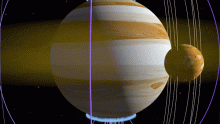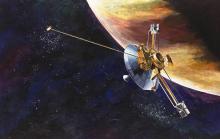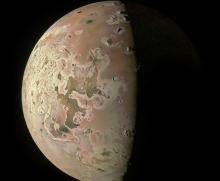Listen to today's episode of StarDate on the web the same day it airs in high-quality streaming audio without any extra ads or announcements. Choose a $8 one-month pass, or listen every day for a year for just $30.
You are here
Moon and Jupiter
Anyone who’s self-conscious about their weight might not want to visit Jupiter. Surface gravity on the solar system’s largest planet is more than twice as strong as Earth’s. So a person who weighs 150 pounds on Earth would weigh about 380 pounds on Jupiter.
Jupiter doesn’t actually have a surface for you to stand on. The planet is a big ball of gas, with nothing “solid” until you drop tens of thousands of miles below its cloud tops.
For comparison purposes, though, scientists have come up with a definition for the “surface” of Jupiter and the solar system’s other giant planets. It’s the depth in the atmosphere where the pressure is equal to the surface pressure on Earth.
That’s far below the tops of Jupiter’s highest clouds. But there are zones in the atmosphere where the clouds aren’t nearly as high, so the “surface” isn’t necessarily below them.
All of this means that no one will ever walk on Jupiter. It might still be possible to visit the planet, though. Visitors could float through the sky in balloons or blimps, or cruise in specially designed aircraft. But the seats would need to be well padded — to handle the passengers’ extra weight on the solar system’s largest planet.
Jupiter is just climbing into view in the eastern dawn sky. It looks like a bright star, but it’s so low that you need a clear horizon to spot it. It’s easier to pick out tomorrow because it’s a whisker away from the crescent Moon.
Script by Damond Benningfield





